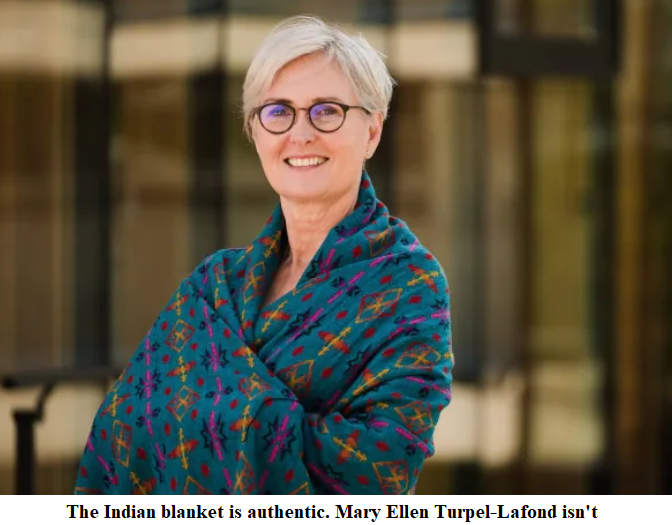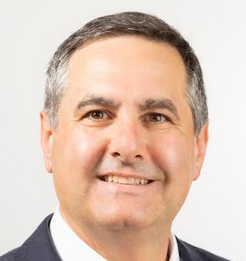
Indigenous voice indeed. No one speaks for the indigenous people of the Norway House Cree Nation except the people of the Norway House Cree Nation (or their democratically-elected representatives). Recognised by treaty on September 24, 1875, the Norway House Cree maintain their own high school, health centre, sewage treatment plant—and membership roll.
One person who is not on the membership roll is Professor Mary Ellen Turpel-Lafond, JD, OC, KC (disputed), holder of a dozen or so honorary doctorates (no one is quite sure), and until recently the academic director of the Indian Residential School History and Dialogue Centre at the University of British Columbia.
Much like a certain prominent professor of indigenous agriculture at the University of Melbourne, Turpel-Lafond traded on her claimed indigenous ancestry to become one of Canada’s most-lauded public intellectuals. But when her father’s birth certificate proved beyond any reasonable doubt that she had no actual indigenous ancestry, the Canadian intellectual establishment turned against her and her career fell apart.
This, despite the fact that she is a bona fide indigenous woman by marriage, accepted by her husband’s Muskeg Lake First Nation as a member of their tribe, in a country where indigenous status is by law granted to the non-indigenous wives of indigenous men.
Canada’s ‘First Nations’ are a tough bunch, and they guard their rights jealously. They have not hesitated to call out ‘predendians’ (pretend Indians) who “engage in colonial violence by stealing Indigenous identity from a place of privilege”. But the Indigenous Women’s Collective behind this condemnation aren’t so much angry with Turpel-Lafond as with the mainstream Canadian institutions that have honored and employed her. They are angry that white Canada has turned to Turpel-Lafond as its preferred indigenous voice.
Indigenous Canadians are fortunate to have democratic institutions through which to express themselves: the First Nations tribes. These organisations offer truly authentic, much more legitimate alternatives to the narrow class of privileged intellectuals chosen by mainstream institutions to be the compliant spokespeople for indigenous opinion. As the Turpel-Lafond controversy shows, it’s still difficult for real Canadian First Nations to have a say on indigenous matters. But at least they’re able to create a controversy.
IN AUSTRALIA the dominance of the professional indigenes is near-absolute—and the current proposal for an appointed (anointed?) Voice to Parliament will make it completely absolute. In one of the great ironies of indigenous affairs, ordinary Aboriginal and Torres Strait Islanders were not consulted on the proposal to create a Voice to Parliament and (by all accounts) will not be consulted on its structure or membership. They will be ‘gifted’ a Voice, not given a voice.
Tellingly, where indigenous Australians do have organised democratic institutions, there has been pushback. In South Australia, most of the state’s native title bodies have protested the creation of a state-level First Nations Voice that is not based on existing indigenous native title bodies. The New South Wales Indigenous Land Council has expressed similar concerns about the proposed national Voice to Parliament.
Troublingly, few people seem to care what these actually existing indigenous voices have to say about ‘the’ Voice. Their parliamentary submissions have gone unaddressed. Their leaders are not sought out for comment by the country’s major newspapers. Their opinions on indigenous matters don’t seem to matter. The land councils—for all their faults, the only democratically organised indigenous representative bodies in Australia—have essentially been ignored in Australia’s ‘Voice’ debates.
The Liberal and Labor parties have both had a crack at the indigenous Voice, and both have proposed mechanisms that involve the appointment of privileged intellectuals to speak to Parliament. Both have, in essence, offered sit-down money to the indigenous rights industry to get them off their backs. Whether Constitutional or merely legislative, no such ‘pretendian’ Voice will ever bring reconciliation to Australia.
As the Canadian Indigenous Women’s Collective says, “reconciliation starts with truth”. White Australia is still living the lie on indigenous matters, listening to the small number of indigenous voices it wants to hear instead of the multitude of indigenous voices who have every right to talk. If indigenous Australians are serious about being ‘first nations’, and if non-indigenous Australia is serious about listening to them, then a democratically-constituted Voice is the answer.
A sham Voice will only set Australia back two decades to the ATSIC era, and a sham Voice enshrined in the Constitution will keep Australia back for decades to come.
Salvatore Babones is The Philistine
 Sign In
Sign In 0 Items (
0 Items ( Search
Search









Salvatore this insight into Canadian Indians and pretendians is much appreciated. To be a First Nations Indian does one have to be at least quarter blood/caste as was the Nazi cut off for Jewishness?
We are now seeing in Alice Springs the social breakdown and violence caused by an aimless life on sitdown money and now, with Labor removing the cashless credit card, seeing the devastating effect of welfare provided firewater, to culturally appropriate an American Indian expression.
Jacinta Price tells of this problem but the well educated aboriginal elite in the cities with their Voice proposal for Canberra jobs seem to have no interest in solving the problem of remote indigenous communities.
Integrating aboriginal people into modern Australia was working well until the likes of the socialist educated HC ‘Nugget’ Coombes was appointed consultant to Gough Whitlam during 1972-1975. Land rights and preservation of culture then displaced integration, and 50 years on the Voice offers no new solution. Far better we dispense with the racially divisive Voice and we revert to integration which has given employment and a highly comparable standard of living to urban aboriginal Australians.
@ Brandee
LOVE this –
” Integrating aboriginal people into modern Australia was working well until the likes of the socialist educated HC ‘Nugget’ Coombes was appointed consultant to Gough Whitlam during 1972-1975.
Land rights and preservation of culture then displaced integration, and 50 years on the Voice offers no new solution.
Far better we dispense with the racially divisive Voice and we revert to integration which has given employment and a highly comparable standard of living to urban aboriginal Australians.”
I would add – remove race-based welfare; ditch the $34billion budget wherein too many organisations use that to put in ‘cultural days’ on the east coast of NSW where people have lived an urban lifestyle.
Let’s get back to the way it was before the Wave Hill Walk-off by Vincent Lingari.
All aboriginals worked alongside every other Australian.
Needs-base welfare for all Australians.
@Salvatore – the word ‘reconciliation’ is really troubling for me.
You stated :
“will ever bring reconciliation to Australia.”
What reconciliation?
When have we had to reconcile differences?
Really, I was only picking up on the language of the Canadian group.
Good onya, NarelleG — that’s a question I’ve been asking for years, and nobody has yet provided an answer. My understanding is that “reconciliation” can occur only between two (or more) parties that have grown estranged, i.e. once had a solid relationship, which has now disintegrated. It can’t be a unilateral process.
In my experience, Aboriginal dwellers in remote communities have never had much of a relationship with the wider Australian community (apart from using it as their magical, mysterious source of all material needs, including food, housing, power, health care, electronic entertainment, air transport, vehicles and fuel), but do expend a lot of time and energy on interacting with neighbouring groups, generally in a hostile fashion, given their ancestral hatreds. Before they could even think of reconciling with the mainstream, it would be imperative they sorted out their own, long-standing squabbles: reconciliation begins at home.
As for indigenous folk living in cities and towns (80% of the total), I’d guess most just go about leading normal, average lives, indistinguishable from the rest of us (unless they choose to advertise it), and not in need of stitching up broken-down relationships with their compatriots any more than, again, the rest of us.
Then, there’s that other, elite, small but growing group, the industrial representatives, a.k.a. nomenklatura, who have established comfortable and lucrative careers out of preaching victimhood and racism, who prefer not to define “reconciliation” (or “racism”, for that matter), but simply use such terms as an effective, if meaningless, knee-jerk weapon to elicit guilt from the rest of us. Not a healthy basis for a harmonious society — and The Voice will serve only to further entrench these meaningless but handy terms. We’ll never hear the end of them, regardless of how the referendum works out — or even if it doesn’t go ahead.
….‘predendians’ (pretend Indians)”
‘pretendians’?